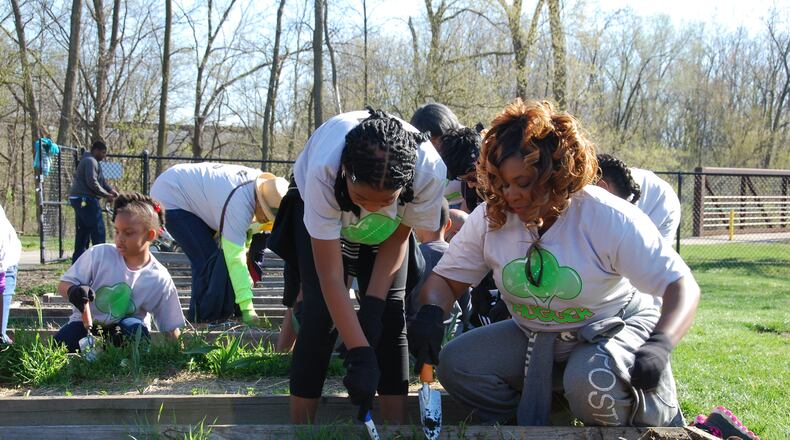“Now is the time to start prepping the garden for spring plantings,” said Kaitlyn Lowry, Five Rivers MetroParks education coordinator, Community Gardens and Farm Programming. “Planning out your garden and purchasing seeds is something a lot of people are doing at this time. There are some neat garden planning tools that can help gardeners — new and experienced — in planning out what they’ll be planting, where they’ll be planting it, how much they’ll be planting, and other things, such as succession planting and companion planting.”
Rule of thumb
“Generally speaking, you weren’t supposed to start planting your summer vegetable seedlings and seeds before the last frost date,” Lowry said. “Climate change has made our first and last frost date harder to pin down and predict.”
Mother’s Day has traditionally been used as a marker for when it’s safe to plant outdoors, but there are plenty of exceptions.
“You can plant cool weather plants before the last frost date,” Lowry said. “Depending on the trends of the season, you can plant things like sugar snap peas outside the last week of March or early April. Brassicas like collards and kale and broccoli can also withstand some cold temperatures, but will require some cover during cold snaps. You can also plant carrots and beets and certain lettuce varieties around the same time.”
Getting started
If you’re itching to get started, there are some early spring options.
“A fast and cheap way to plant things after mid-March is to take a clear storage bin and place it over your sown seeds or seedlings to help act as a little mini greenhouse,” Lowry said. “The warmth will help the seeds sprout and the bin will also protect the seedlings from frost damage while still letting enough light in to grow. On warmer days — anything above 35 degrees or so — you can remove the bin-cover and allow the seedlings some much needed airflow and wind, which will help prevent mold and disease issues that can spring up in covered conditions.”
Milk jugs are also an inexpensive option for starting seeds – a technique that is being utilized at the Possum Creek Demonstration Garden again this season.
“I love that this is a seed starting method that is cheap, reuses and repurposes used clear plastic jugs, and doesn’t require extra electricity or daily watering,” Lowry said. “It’s low maintenance, you don’t have to purchase special seed trays or lights, and you can start nearly every common vegetable garden plant with this method – though not all as some like to be sown directly in the spot they are to grow in all season and hate being transplanted.”
The MetroParks also have several gardening classes slated over the next month to help participants get prepared for planting.
MetroParks upcoming gardening events
All events are at Cox Arboretum MetroPark. For information, visit www.metroparks.org.
- Spring Color in the Garden: All Plant Types: Learn about native and cultivated plants that bring the best color and when, so that you can plan spring cascades of bloom for your own garden. 10-11:30 a.m. March 9
- Planting Early Gardens: Learn how to select the best plants and seeds to put in now and how to prepare for spring’s unpredictable weather. Get color and veggies in spring and prepare for the warm-weather planting season. 10-11:30 a.m. April 6
- Propagating Spring Wildflowers: Learn how to identify spring wildflowers and learn how and when to propagate them for a spot in your garden. Learn the soil and sunlight conditions required for their success as well as how to protect them after they go dormant. 10-11:30 a.m. April 13
Gardening Planner
- Timeline for chores is weather dependent. We’ve not had consistent temperatures all winter, and it’s important to wait until soil is warm enough for gardening activities.
- Cutting back stems on perennials should only be done after day and night temperatures are consistently above 50 degrees. This allows insect larvae and eggs in hollow stems time to emerge.
- Perennials should not be divided until we reach the 50-degree mark. You can, however, decide which clumps can be divided and where you will put the divisions.
- Pruning of spring blooming shrubs and trees should take place after they have bloomed. As soon as the bloom is done, prune immediately.
- Knowing what is hardy in our zone is important so you don’t purchase plants that can’t take our winter cold. Search nurseries and online dealers for zone 6b plants.
- Keep winter protection/mulch until mid-April. Have sheets or row covers ready in case of extreme cold weather or snow after that.
- Plant summer blooming bulbs after the soil is warm, in late April. Before then the soil is too cold and damp and bulbs will rot, after then is too late for them to get growing. You can plant bulbs in containers in April as the soil will be warmer.
- Start fertilizing tropicals that you have kept indoors for winter in March. Re-pot them in April if they have outgrown their containers.
- Plant sales are advertising now for later dates. Don’t buy in April with the thought of putting plants out then, as it’s still too cold. You can pot them in containers and protect them from cold weather by putting them in an unheated garage or shed at night and out in part sun during the day.
Source: MetroParks education coordinator Betty Hoevel
About the Author

